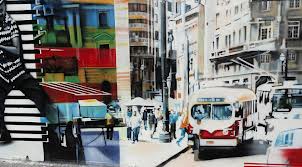How to develop urban murals based on the swot strategic models
Keywords:
design, mural, city, planning, strategy, SWOTAbstract
Art history spanning the life of humanity, which had its basis, to express ideas, create peace or creating emotional disturbances, to pay. The art of creating images on rocks, skirts Nature, wall or generally called the graffiti art, which is now, in many cities around the world and Iran, from various reasons, use the should in this context, to formulate a basic strategy, according to various options, should be taken. This study, based on the method of analysis - statistical, and retention of existing resources, in this context, and use of strategic models of SWOT, the basic strategy for the optimal development of the wall paintings in the city of Iran is discussed. Based on the obtained results, it can be stated that, drawing on ethnographic murals, public demand is from people who benefit from a weighted score of 0.64, in the first place strengths, not enough attention the interests and needs of people in the field of graphic design, with a weighted score of 0.44, in the first place weaknesses, taking advantage of experienced professionals, with a weighted score of 0.56, has the highest weight rating, and the first opportunity to available, and the non- utilization of specialist and experienced widely, with a weight rating of 0.7, in the first place threats, lies. Based on these, the most important, strategic strategies, tailored to the context of the wall painting can be a key focus in the field of graphic wall design, based on the desires of the people, especially the youth, and the use of skills, expertise and experiences of individuals in the field, optimal utilization of symbols, culture, identity and historical and natural attractions in the wall painting design, and combines it fits with the development and modernity to the world, and taking advantage of the artist Maher, in this country there are also plans to create a fascinating and confusing, according to citizens' demands, said.References
Eskandari, I., 2012. Fences, birth city, colored, paper jam, 19 December, 8.
Poorjafar, M., et al., 2009. Regulatory Impact readings ( based on the promotion of the city ( urban quality ), urban public spaces ( Case Study, Tehran Azadi Street ) ), Dvfslnamh Urban Management, No. 24, 66.
Hosseini seyed Baqer and Sina Razaghi asl., 2008. the movement and the urban landscape ; ideas and design concepts, Mhndsb International Journal of Architecture, Volume 19, Number 6, 84.
Haghighatshenas, J., 2013. the wave is called Urban Art, Tehran newspaper today, 24 May, 7.
Solaimani, S., 2012. Graffiti, skin fickle town, a young journalist, Issue 3664, 2 May, 10.
Sharifzadeh, S., 2012. city walls speak Shahrara Newspaper, No. 1094, 28 March, 10.
Kiani, A., Farzaly Salari, S., 2011 . review and evaluate priorities in terms of public spaces, Assaloyeh with using ANP, Journal – Res. Garden, No. XVIII- th year, 25.
Moosavi, N., 2013. in the absence of urban beauty, cultural newspaper, nineteenth year, No. 5345, May, 17.
Hangr, J.D., Thomas, L., violin., 1381. Foundations of Strategic Management, translated by Syed Mohammad Arabi and David Divine, publ. Cultural Res. Bureau in Tehran. First Edit., 105-90.
Crow, Thomas. Brown, Terry. De Young, Raymond., 2006. The Riverside and Berwyn experience, Contrasts in landscape structure, perceptionsof the urban landscape, and their effects on people, Landscape and Urban Planning., 75 3-4, 282,299.

Downloads
Published
How to Cite
Issue
Section
License
Copyright (c) 2014 Ghodrat Heidari, Ali Jafari, Bahman Shafiei, Farahnaz Nooraei

This work is licensed under a Creative Commons Attribution-NonCommercial-NoDerivatives 4.0 International License.



